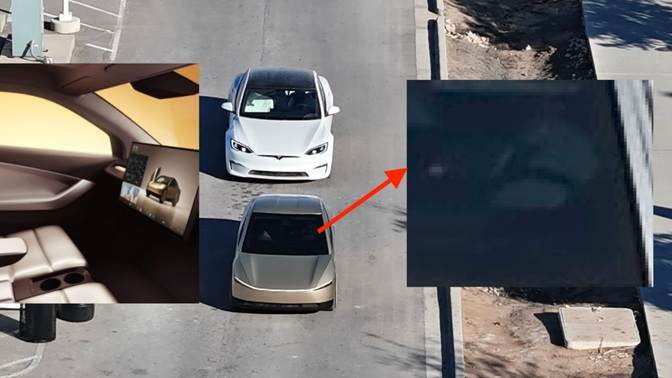Tesla never fails to spark conversation when it comes to its bold vision for the future of transportation. The latest buzz surrounds the Tesla Cybercab (also called the Robotaxi), a two-seat electric vehicle that the automaker envisions as the backbone of its future autonomous ride-hailing fleet. However, a recent sighting of a Cybercab with a steering wheel at Tesla’s Gigafactory Texas has raised eyebrows and questions. Is Tesla rethinking its autonomous ambitions, or is this just a necessary step in the testing process? Let’s unpack the details.

What Is the Tesla Cybercab?
The Tesla Cybercab was unveiled as a fully autonomous, steering wheel-less vehicle aimed at revolutionizing urban transportation. Tesla plans to deploy the Cybercab as part of a fleet of robotaxis—essentially self-driving cars designed for ride-hailing services. At its debut, Tesla showcased the Cybercab on private roads, offering test rides. While the concept was intriguing, it didn’t demonstrate capabilities beyond Tesla’s current Full Self-Driving (FSD) technology.
Tesla is betting on its ability to make its FSD software completely unsupervised by 2026, which is when the Cybercab is expected to go into production. This is a bold claim, especially since the existing FSD software is still considered a supervised system, requiring drivers to remain attentive and ready to take control. Industry experts remain skeptical about Tesla’s timeline, noting that no significant breakthroughs have been demonstrated to justify such optimism.
The Steering Wheel Mystery
The recent sighting of a Cybercab equipped with a steering wheel at Tesla’s Gigafactory Texas has fueled speculation. The image, taken by drone enthusiast Joe Tegtmeyer, initially caused confusion, as some wondered whether it was just a shadow. However, enhanced contrast and exposure on the image confirmed the presence of a steering wheel.
This discovery raises two key questions:
- Is Tesla planning a consumer version of the Cybercab with a steering wheel?
- Is the steering wheel merely a testing tool to comply with current technology and regulations?
While some enthusiasts might hope for a consumer-friendly Cybercab, Tesla has been adamant that this vehicle will launch as a fully autonomous product without a steering wheel. The more plausible explanation is that the steering wheel is being used for testing purposes, allowing the Cybercab to operate with driver supervision during development.
Why Add a Steering Wheel?
The presence of a steering wheel in the Cybercab could be a practical necessity for several reasons:
- Testing with Driver Supervision
Since Tesla’s Full Self-Driving technology is not yet capable of fully autonomous operation, the steering wheel allows for supervised testing. This ensures safety during development and enables Tesla to collect valuable data while remaining compliant with regulatory requirements. - Avoiding Autonomous Driving Regulations
Current regulations around autonomous driving tests are strict and require extensive reporting. By including a steering wheel and conducting supervised trials, Tesla may be bypassing some of these requirements, allowing for faster iteration and testing. - Unsupervised Trials in Question
Tesla CEO Elon Musk recently claimed that the company is conducting “unsupervised self-driving trials” with employees. However, there’s no evidence to support this, as Tesla lacks the necessary autonomous driving permits. The Cybercab with a steering wheel suggests that these trials are likely supervised, which aligns more closely with current regulatory standards.
Tesla’s Autonomous Ambitions
Tesla’s vision of a fully autonomous future is ambitious, to say the least. The Cybercab represents a bold step in this direction, but significant hurdles remain. Here are some of the key challenges Tesla faces:
- Regulatory Approval
Autonomous vehicles must meet stringent safety and reporting standards before they can operate on public roads without supervision. Tesla has yet to secure such approvals, which could delay its plans for the Cybercab. - Technological Readiness
Tesla’s FSD system has made progress but remains far from unsupervised operation. The only data available suggests that achieving full autonomy will require significant advancements in AI and sensor technology. - Public Trust
For autonomous ride-hailing services to succeed, Tesla needs to build public trust. This requires not only demonstrating safety but also addressing concerns about reliability and ethical decision-making in AI systems.
What Does the Steering Wheel Tell Us?
The Cybercab’s steering wheel is more than just a physical feature—it’s a glimpse into Tesla’s development process and the challenges of achieving full autonomy. While the company has painted a picture of a steering wheel-less, fully autonomous future, the reality is that getting there will take time, testing, and perhaps a dose of humility.
The inclusion of a steering wheel for testing suggests Tesla is taking a cautious approach, ensuring safety while collecting data to refine its systems. This step could also reflect the company’s recognition that regulatory approval for unsupervised vehicles won’t come as quickly as initially hoped.
What’s Next for the Cybercab?
With production slated for 2026, Tesla has a few years to overcome the challenges of making the Cybercab a reality. The company will need to prove its FSD technology can operate reliably and safely without supervision, secure regulatory approval, and address the weighty task of public perception.
In the meantime, sightings like the Cybercab with a steering wheel remind us that progress in autonomous driving is often incremental. Each step, whether it’s adding a steering wheel for testing or refining AI algorithms, brings Tesla closer to its vision.
Tesla’s Cybercab represents both the promise and the complexity of the autonomous vehicle revolution. While the idea of a steering wheel-less robotaxi is exciting, it’s clear that the journey to full autonomy is far from over. For now, the sight of a steering wheel in a vehicle designed to operate without one serves as a reminder that even the boldest visions require a steady, step-by-step approach to become reality.
What are your thoughts on Tesla’s Cybercab and the future of autonomous driving? Share your opinions in the comments below!
Related Post
